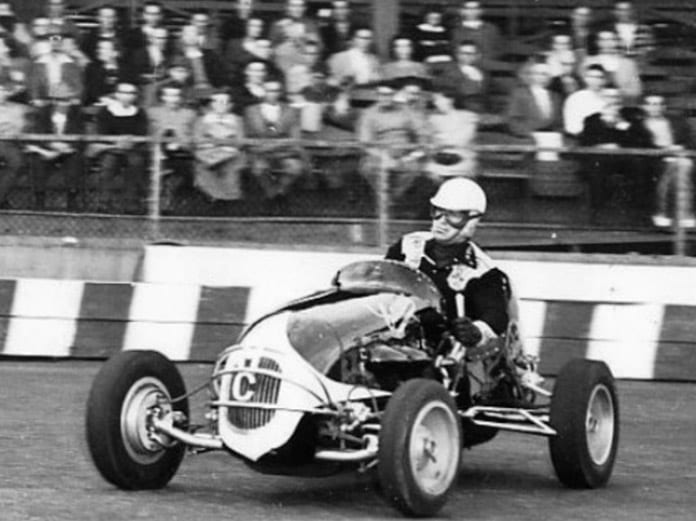In an era when sportswriters tagged competitors with colorful nicknames, William Lawrence Schindler earned a few — “Bronco Bill,” “Wild Bill” and after a tragic 1936 accident, “One-Legged” Bill Schindler.
Born in Freeport, Long Island, in 1909, Schindler lost both his parents as a teenager. Before they died, however, he spent hours tinkering in his dad’s automotive shop. Anything with an engine captivated him.
That fascination led to racing motorcycles with his buddies in a field near his home. When that became boring, he turned to four wheels and found his way into a “big car.”
His talent, evident early, took him to wins in Watertown and Deer Park, N.Y., after only four outings.
Schindler soon began racing midgets and ran with several organizations, including the AAA. Winning came easy.
By mid-1936, he’d wrapped up the EMRA midget championship and took time to attempt some other racing disciplines. He’d already ran stock cars with the AAA in a 250-miler on the Daytona beach course when a large- purse sprint car race in Mineola, N.Y., caught his attention.
He entered it and it changed his life.
Trying to squeeze between another car and the fence, Schindler ran out of room and took a wild ride out of the track. The crash shattered his left leg. When infection set in, the leg was amputated.
He didn’t win the day he was released from the hospital, as legend maintains, but Schindler wasn’t about to allow something like a missing leg slow him. He raced without a prosthesis and by the spring of 1937 he’d claimed an indoor midget title and won the James Cagney trophy at Boston Gardens.
That performance earned Schindler a ride in the potent Mike Caruso midget. And in the years leading to World War II, the team was virtually unstoppable. In 1940, East Coast car owners formed the ARDC to get from under the oppressive AAA. They elected Schindler their president, a position he held for eight years. He was also the first club champion after winning 21 features.
Unable to serve during WW II because of his missing leg, Schindler devoted hours to visiting military hospitals who had lost limbs in combat. His example of achievement in a rough-and-tumble sport inspired war-torn young men to believe they too could battle their way past devastating injuries and lead normal lives.
With the resumption of racing after the war, Schindler ripped through ARDC competition. He captured the 1945 and ’46 titles. In 1947, he won an incredible 53 features. Proving this rarified accomplishment wasn’t a fluke, he performed a similar feat in 1948, winning another 53 features and the championship.
By 1949, midget racing was on the downslide and Schindler looked to Indianapolis Motor Speedway.
He arrived at the speedway in 1951 without a ride, remarking to a friend, “I guess I’ll get a job on a pit crew sweeping up.”
AAA official Frankie DelRoy took a liking to Schindler and arranged a ride in Lou Rassey’s striking orange and black Auto Shippers Special.
Schindler was the fourth fastest qualifier but started 16th because he did not turn that lap on the first day of qualifying. He raced up front before a universal joint failed. His performance opened the door for other Indy car rides and he performed well.
Schindler produced a second-place finish in Sacramento, Calif., a third-place effort at California’s Bay Meadows Speedway; a track record and second-place run at Darlington (S.C.) Raceway; and a runner-up effort at Wisconsin State Fair Park.
Two more Indianapolis runs and more solid finishes led to his first championship victory when he caught Jack McGrath at the checkered flag to win at the Illinois State Fairgrounds on Aug. 16, 1952.
Schindler was just as competitive in the AAA sprint cars. In 1951, the Eastern title chase went down to the last race of the year, and he finished second in the championship to Tommy Hinnershitz.
Chasing the AAA Eastern Sprint championship in 1952, Schindler asked Mike Caruso to help him in Allentown, Pa., on Sept. 20. They had the car singing. While leading his heat, another driver crashed. Schindler couldn’t avoid the rear axle and wheels torn from the wrecked car. He catapulted high in the air, vaulted the fence and struck a ticket booth 50 feet outside the track.
When rescuers arrived, Bill Schindler was dead.
